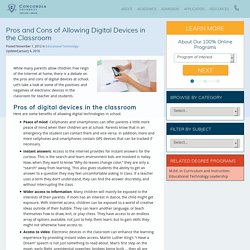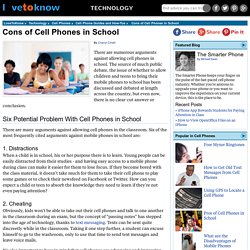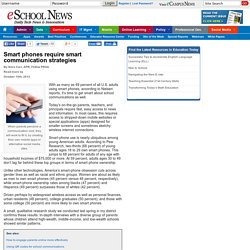

Create a Free Website, Online Store, or Blog. Pros and Cons of Allowing Digital Devices in the Classroom. While many parents allow children free reign of the Internet at home, there is a debate on the pros and cons of digital devices at school.

Let’s take a look at some of the positives and negatives of electronic devices in the classroom for teacher and students. Pros of digital devices in the classroom Here are some benefits of allowing digital technologies in school. Peace of mind: Cellphones and smartphones can offer parents a little more peace of mind when their children are at school. Parents know that in an emergency the student can contact them and vice versa. Pros of Cell Phones in School. Although much of the public debate is against it, there are pros associated with allowing cell phones in school.

These advantages should not be ignored since cell phones in schools can actually add value to the educational experience, rather than simply be a detriment to it. Seven Pros of Cell Phones in School There are positive outcomes that can emerge from permitting students to bring their cell phones into the classroom. Consider the following advantages when forming your opinion regarding whether cell phones should be allowed in school. 1. Although you hope that you will never have to do this, you sometimes need to get in contact with your school-aged child while they are in class. 2. Students who have a smartphone can use various applications that are designed to assist in learning and designed just for students. 3. Most cell phones have a camera these days, so children can use these to take pictures of things in class. 4. 5. 6. 7.
Weigh Both Sides Post a comment. Cons of Cell Phones in School. There are numerous arguments against allowing cell phones in school.

The source of much public debate, the issue of whether to allow children and teens to bring their mobile phones to school has been discussed and debated at length across the country, but even now, there is no clear-cut answer or conclusion. Smart phones require smart communication strategies. By Nora Carr, APR, Fellow PRSARead more by October 10th, 2012 When parents perceive a communication void, they will work to fill it, by creating their own mobile apps or alternative social media sites.

With as many as 49 percent of all U.S. adults using smart phones, according to Nielsen reports, it’s time to get smart about school communications as well. Today’s on-the-go parents, teachers, and principals require fast, easy access to news and information. In most cases, this requires access to stripped-down mobile websites or special applications (apps) designed for smaller screens and sometimes sketchy wireless internet connections. Smart-phone use is nearly ubiquitous among young American adults. Unlike other technologies, America’s smart-phone obsession cuts across gender lines as well as racial and ethnic groups.
A small, qualitative research study we conducted last spring in my district confirms these results. How to Use Cell Phones as Learning Tools. Does your staff need Educational Technology training?

The K-12 Teachers Alliance can help you plan your in-service professional development at no additional cost. Regardless of your school’s cell phone policy, the reality in most schools is that students have phones in their pockets, purses, or hoodies. Why not get these tools out in plain sight and use them for good and not evil? Cellphones in the Classroom: Distraction or Tool? The final version of the National Education Technology Plan (NETP) was released last week, setting forth the Obama Administration's plan for improving access to and integration of technologies for teaching and learning.

Among the recommendations the Department of Education makes in the NETP is a call for support for "efforts to ensure that all students and educators have 24/7 access to the Internet via devices, including mobile devices, and that states, districts, and schools adopt technologies and policies to enable leveraging the technology that students already have. " The push for "24/7 access to the Internet" falls under another the auspices of yet another endeavor, the National Broadband Plan.
But the call for better access to Internet-ready devices, particularly utilizing tools the students already possess is an interesting one. Because the device that is ubiquitous for American students isn't the desktop computer or the notebook or the netbook or the iPad. The "BYOD" Debate - Educational Technology for School Leaders. 1.

Cost Effective way to increase technology in schools. (ALM)"It goes without saying the a BYOD policy allows a district to get closer to a 1 to 1 device ratio without incurring the costs of a 1 to 1 program. " - Oak Hills Portfolio, Cincinnati. Oak Hills Portfolio When students are able to bring their own device to school, the school is saving money on the cost of purchasing device. Districts are facing more budget cuts and money restraints than ever before, so by allowing students to bring their own device, districts can save money. Student-provided devices frees money so the district can provide for those who cannot afford their own. 2. BYOD Policy Chequamegon School District. Mlearning - List.